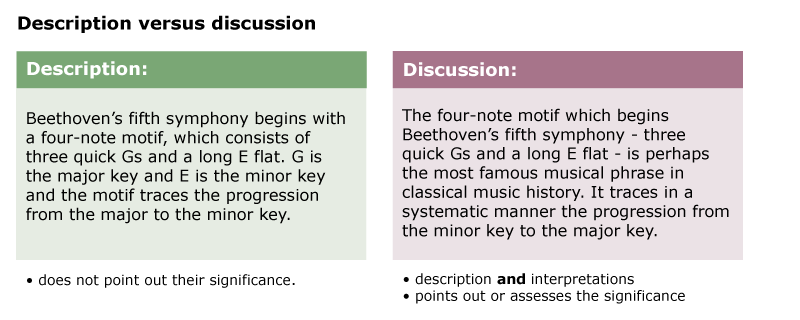Understanding essay types
Introduction
At university, you have to demonstrate the ability to write different types of essays. The aim of this unit is to study the style features of three main types of essays: expository, discussion and argumentative.
Although all university writing is essentially argumentative, most essays have elements of exposition, discussion and argument. A critical review or literature review, for example, may begin with a brief outline or summary of what the article or book is about and its relation to a particular field and the author's viewpoint, before discussing the weaknesses and strengths of the article.
At university, you do not just write your own opinion; your opinion is often an informed opinion, formed from reading and synthesising other people's opinions. You will then support your opinion or claims with evidence and relevant theory. At university, you do not just describe; you analyse, examine, explain, interpret, discuss, assess and evaluate.
In this unit, we will look at:
- some definitions of each essay type (expository, discussion, and argumentative)
- their characteristic features
- some sample essays
Definitions
While all academic essays have the same basic structure – they all begin with typical introductions, develop ideas in body paragraphs, and end with typical conclusions – there are variations in the style of delivery and organisation of the ideas to fit the purpose of the essay. You may find these broad dictionary meanings useful:

Source: Collins Cobuild English language dictionary. (1987). London: William Collins Sons & Co Ltd.
Expository essays
The main purpose of expository essays is to present information on an event, situation or issue. It involves providing detailed and factual descriptions, extended definitions and explanations or examples.
Questions denoting this type of essay often have these function words:
Describe ... and explain ...
Explain what ... why and how ...
What are the main features of ... ? How can ... be solved/implemented ... ?
List and provide ...
Define and explain; Identify; Choose one ... and illustrate what/how ...
Indicate ways in which ...
Outline; Summarise; Compare and contrast ...
Name and give two examples of ... ; Account for ...
Compare and contrast ...
Below are three expository essays with some brief comments on structure, style and language features. Click on the title to view.
Essay sample 1: Styles of rock and roll music
This essay has a clear structure. Each paragraph begins with a relevant topic sentence. There is a lot of descriptive detail supported by examples. The introduction, however, still carries a thesis that is repeated in the conclusion: that “there is no stopping rock and roll”. The language is formal, the writing style is non-contentious, and the tone is authoritative.
Essay sample 2: Extract from a Resources and Environment paper
This is an assignment for a Geography paper. Here, the style is also descriptive and formal. The use of headings is also typical of such essays in the 2000-3000 word range.
Read the full essay from Rountree, K. (1991). Writing for success: A practical guide for New Zealand students. Auckland: Addison Wesley Longman. pp. 107-122.
Essay sample 3: Japan and the United States: Different but alike
This comparison/contrast essay has an expository style, but there are some discussion essay features. Not only does it identify similarities and differences, it compares as well as explains. Sometimes, there is a clear point of view to indicate the significance or importance of either the similarities or the differences.
Sequencing of the information is important in such essays, and there is a higher than normal use of transitions (signal words or logical connectors) to show different relationships between ideas. The essay has a standard academic essay structure: an introduction (based on the `broad to narrow' model), body paragraphs (developed using the SEC model), and a conclusion (constructed using the 'narrow to broad' model).
Read the essay and then answer the following questions:
Discussion essays
Discussion essays go further than expository essays; they analyse and consider ideas from several points of view, and interpret their significance to the discussion topic. Questions requiring a discursive writing style may have these function words (in bold) or question types:
Analyse three components of the urban crisis in the United States.
Examine the relationship between ... and ... with specifc reference to ...
Compare and contrast the ... between ... and ...
Consider the extent to which ...
Comment on the practices of ... and suggest briefly how they relate to ...
Discuss the effects of ... on ...
How would you establish the status of ... as a social problem in New Zealand?
Are any of the ... relevant to ...?
Description versus discussion
A common remark made by markers of discussion essays is that there is “too much description and insufficient discussion”. What do they mean by that?
In general, description is concerned with providing details and facts to explain what something is or is like. In statistics, for example, merely giving the figures as they appear in the graph or table, without pointing out significant trends shown by the figures, is description.
Discussion generally requires some interpretation of the figures, that is, an explanation of what they mean and how they are significant.
Click here to view an example.

Discussion versus argument
Both discussion and argument are concerned with issues, but the basic difference lies in the degree of force about the issues.
Argument is about trying to prove that a certain point of view (this could be your informed or expert view after research) is the correct one.
Discussion presents an argument in a more balanced way; it examines several points of view. A discursive writing style is therefore more exploratory. It may not consistently argue for or against a point, but it may still have an overall thesis (point of view) to indicate to the reader where your discussion is heading.
An essay question requiring a more persuasive argumentative style may be written like this:
- Should all public places be smoke-free?
- All public places should be smoke-free zones.
- Write an argumentative essay arguing for or against one of the following statements:
- Art is corrupted by commerce.
- Money is the root of all evil.
An essay question requiring an exploratory and discursive style may be written like this:
- Discuss the impact of making all public places smoke-free zones.
Basic features of discussion essays
The following presentation explores the basic features of discussion essays.
Sample discussion essays
The two sample discussion essays presented here represent varying degrees of discursive style. The first combines exposition with discussion; the second combines discussion with argument. Both essays demonstrate some basic principles of essay structure, including the construction of effective introductions, body paragraphs, and conclusions using the models explained in this unit.
 Essay sample 1
Essay sample 1
Sample essay: Impact of iPods on the music retail industry and music consumption
The writing style has elements of exposition and argumentation. The tone is less assertive; the style is exploratory, but the discussion is built around a clear thesis or point of view stated in the introduction.
Answer the following questions:
Essay Sample 2: Language and Gender
This commentary on a literature review attempts to show how the writer of the review combines discussion with exposition, critical analysis and argumentative style (ie, concession and refutation). However, the annotations are not very easy to read; it might be useful to print out a hard copy to study it properly. At the end of the article, you can click on the original document without the comments.
Argumentative essays
Argumentative essays are about issues. They are written to support or refute (argue against) an opinion or claim in order to reach a decision. In terms of writing style, they are more forceful than a discursive essay, because they attempt to effect a change of opinion through reasoned discussion.
Some function words used in questions requiring argument include: Do you agree or disagree with ...? Should ...? Develop an argument for or againts this statement. Discuss the claim that .... To what extent do you agree or disagree with ...?
The language of argument
Academic arguments are characterised more by logical appeal than emotional appeal. If emotional appeal or language were used the writing would read more like a public speech or an oral debate than an academic argument. Avoid the following:
- subjective comments (eg, I believe ...)
- sweeping generalisations, absolute statements or exaggeration without solid evidence (eg, Everyone buys furniture from Trade Me.)
- rhetorical questions: These are not reallly questions. They make the writing style unnecessarily wordy and dramatic, and therefore inapporpriate in academic arguments. (eg, What factors contribute to such a phenomenon? Is this the kind of attitude to be encouraged in young people today?)
- emotionally charged language (The idea is utterly impractical and doomed to fail.)
- exclamation marks (Robots will never supersede humans!)
Click here to view a language summary.
Basic features of argumentative essays
The following presentation discusses some of the features of an argumentative essay.
Sample argumentative essays
In this section you can review some of the basic principles of argumentative essays. The sample essays are shorter than most stage 1 essays, but they demonstrate the conventions of academic essay structure and argmentative style, especially the use of concession and refutation. Some essays have notes in the margins to alert you to the distinctive style features of argumentation. Other essays are followed by some short questions.
 Essay sample 1
Essay sample 1
Read the introduction and the first body paragraph of this essay. The purpose of the extract is to help you understand the style and structure of argumentative essays from what you have learnt about them so far. Use the questions to work through the extract.
Essay Question: Should state or local governments have the power to use surveillance cameras in their communities?
Sample essay: Federal government should regulate the use of surveillance cameras in all states to protect citizens’ rights
 Essay sample 2
Essay sample 2
Essay question: “Separating girls from boys in middle school (years 8 and 9) yields positive results.” How far do you agree or disagree with the statement.
Sample essay: Separating the sexes
 Essay sample 3
Essay sample 3
Question: “The TV effect is a myth”. To what extent do you agree or disagree with this claim?
Sample essay: The TV effect is a myth
Critical reviews
Critical reviews and literature reviews both provide appraisals, but whereas literature reviews usually avoid giving judgement on the positions or ideas of the works under review, critical reviews take a more argumentative approach. They provide a critique of the work.
A critique is a piece of writing produced by“careful, thoughtful examination and judgement of a situation or of a person's work or ideas” (Collins Cobuild English Language Dicitonary, 1987). Typically, it involves “consideration of the strengths and weaknesses of a piece (or pieces) of work in relation to its intended purpose, the evaluation of the contributions that it makes to a field of knowledge, and a comparison with other relevant work that may shed light on its value” (Manalo & Trafford, 2004, p. 45).
Manalo, E., & Trafford, J. (2004). Thinking to thesis. Auckland: Pearson Longman.























